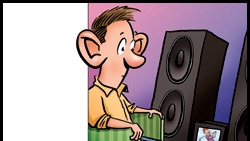Audio versus video: Why video always wins
One thing that has always puzzled me is the way television audio is treated versus video. Why is audio always seen as the underdog? At NAB this year, compare the North Hall with upper and lower South Halls. The former was strangely quiet for a business that makes sound, yet the video hall was crowded, and every other booth had loud presentations.

Last week, I went to visit a large HD OB truck, and the audio area was like a closet compared with the main production area — very typical for trucks.
At the recent AES in Paris, I experienced audio folks up close. After Las Vegas, it was like travelling to another world, where men have long, gray hair and sandals, and in contrast, the women have cropped hair and boots. The show was quiet, more like a national show than international. That meant it was a good opportunity to have a proper conversation with the vendors, rather than the rush from meeting to meeting like NAB. There were several new developments, mainly to support surround-sound production, so it was a real opportunity to learn something new rather than the barrage of marketing in Las Vegas.
The enigma about audio's low profile is this: Try following a TV program with the sound muted. How often do you walk out of the room during a program, just listening to follow the plot? It's just as well you lose the meaning by hitting the mute button; the commercial break becomes tolerable.
Research has shown that mobile video users listen more attentively than they watch. Although it might appear to be a strain watching such a small screen, the viewers follow the plot through the earphones. They are familiar with the characters, so they can look away without missing anything. This is a lesson in how important television audio really is.
So why is audio the poor relation? The budgets are smaller, and the crew is generally much smaller. There is something about making pictures that has always had a certain panache — the classic picture of the director sitting in his chair barking orders through a megaphone at the DOP. The sound man never features in that scenario; he is unseen. We may see the boom operator, but he is using a large piece of equipment and can hardly be avoided.
When it comes to program budgets, again video gets the lion's share. As viewers, however, we expect sound to be clear and easy to understand. Yet the recordist has probably had to use sub-optimal microphone positioning to avoid being in shot; microphones should hear but not be seen.
Get the TV Tech Newsletter
The professional video industry's #1 source for news, trends and product and tech information. Sign up below.
In view of the equal importance of audio and video in terms of conveying the plot, why is video the glamorous side and audio the poor relation?
I used to work for radio but moved to television; perhaps I have answered my own question. I would be interested to hear your views.
Send comments to: • editor@broadcastengineeringworld.com • www.broadcastengineering.com
